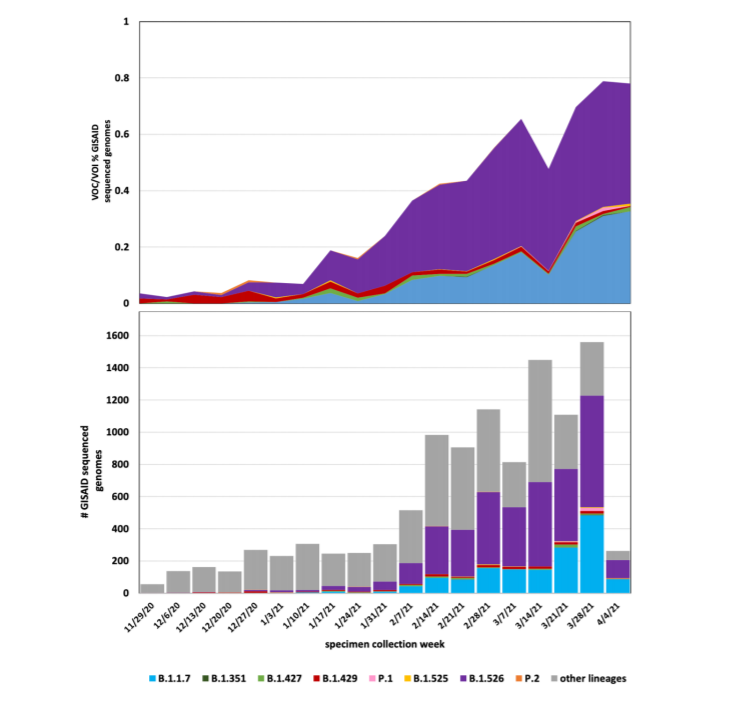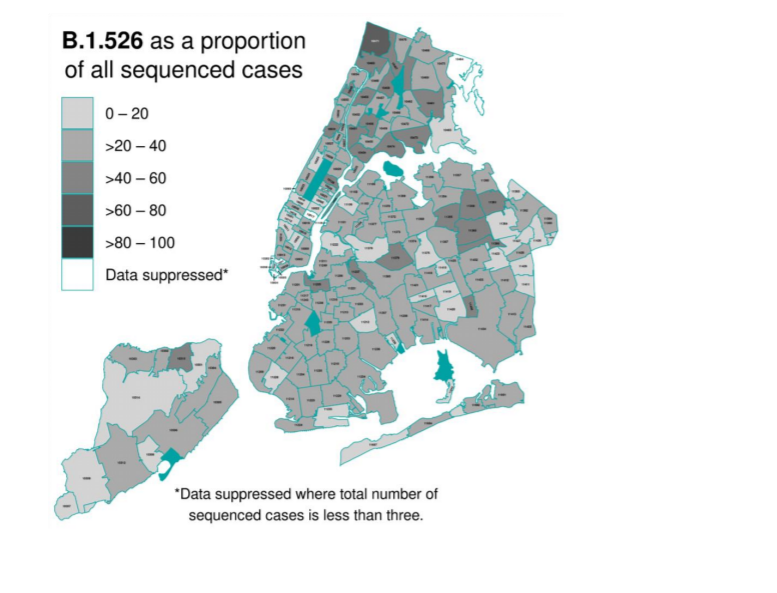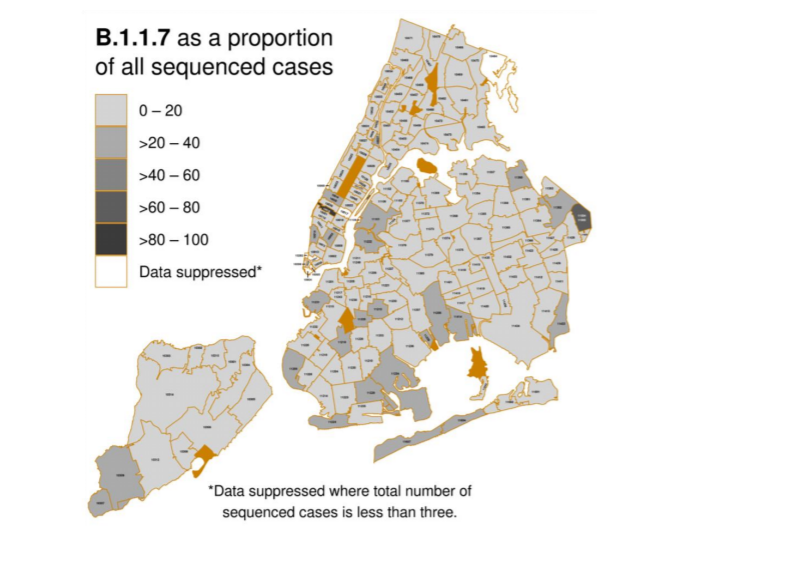Risk of Reinfection, Reduced Vaccine Effectiveness Shown Among Some Coronavirus Variants,
What to Know
- Variants of interest and variants of concern account for more than 70 percent of all new NYC cases, up from about 10 percent in January
- The U.K. and Brazilian variants are considered variants of concern because the first has proven to cause more severe outcomes while the second may be more resistant to vaccines
- New York City health officials say they are looking into whether the Washington Heights variant causes a higher risk of reinfection by other variants or is more resistant to vaccines
More contagious variants are keeping the five boroughs’ daily COVID case counts at a “high plateau” even as the vaccination rollout accelerates, and city officials are looking into whether one that first emerged in Washington Heights last year is more likely to cause reinfection among people who previously had the virus, health officials say.
They’re also still looking into whether it is more likely than other variant types to infect people who have been fully vaccinated and whether that Washington Heights variant, known as B.1.526, contributes to more severe outcomes in terms of deaths, hospitalization and illness, a new health department analysis published Monday says.
The Washington Heights variant, along with the U.K. (B.1.1.7), Brazilian (P.1) and South African (B.1.351) strains have proven to all be more transmissible than earlier strains of COVID, which is why they are known as “variants of concern” or “variants of interest.”
The B.1.1.7 strain is described as a “variant of concern” because evidence shows it causes more severe infections than earlier strains. It may also be more lethal. The P.1 variant also is considered a variant of concern because evidence shows antibodies from previous infection or from vaccination may be less effective against it.
New real time information is allowing scientists at Hackensack Medical Center to develop a new rapid test that detects COVID-19 variants. NBC New York’s Brian Thompson reports.
While research is ongoing to assess the potential threat level from B.1.526, health officials say it accounts for about 34 percent of all positive sample studied since January. The prevalence of all variants has increased dramatically since January.
At that point, variants of concern and variants of interest accounted for about 10 percent of all cases studied. By mid-March, they represented more than 70 percent of cases genetically sequenced in labs. The Brazilian variant accounts for only about 2 percent of samples studied since January, but city officials say its presence is growing.

Handout The city updated its variant data recently.
The B.1.526 and B.1.1.7 variants have been detected in all five boroughs, though the former is slightly more common in the Bronx and parts of Queens. The U.K. strain is slightly more common in southern Brooklyn, eastern Queens and Staten Island.
Thus far, the city has found no evidence to date that either of those two strains reduce the effectiveness of vaccines, health officials said. But further study is needed.

Handout This map shows detection of the Washington Heights variant.

Handout This map shows the prevalence of the U.K. variant.
“To date, reinfection cases and cases in people who were fully vaccinated are rare. It is too early to know if either of these variants are more likely to cause reinfection or vaccine breakthrough compared to other previously circulating variants,” Health Commissioner Dr. Chave Chokshi said. “The increase in proportion of cases that are variants indicates that they may be more transmissible, so New Yorkers should continue to get vaccinated when eligible and adhere to the Core Four.”
While new daily cases, hospitalizations and confirmed virus deaths are all decreasing over the latest two-week period studied, new cases are declining at a slower rate (20 percent) than hospitalizations (41 percent) and deaths (30.5 percent), data shows.
The decrease in more severe outcomes may be associated with higher vaccination rates among the most vulnerable populations, city officials have said. Similar trends hold across the country, which is seeing death and hospitalization rates among older people decline, but the share of younger people in COVID emergency rooms is rising.
Not sure how the process works? Or when you might be able to get an appointment? Check out our handy tri-state vaccine site finder and FAQs here
New York City and New Jersey Vaccine Providers
Click on each provider to find more information on scheduling appointments for the COVID-19 Vaccine.
New cases and emergency room visits are up in younger adults, “most of whom have not yet been vaccinated,” CDC Director Dr. Rochelle Walensky said.
Walensky says the cause of the uptick remains under investigation, but she is among experts who have expressed concern COVID-19 variants are contributing to higher spread rates at a critically vulnerable time in the national vaccine rollout.
The U.K. strain is now the predominant strain in the U.S. As of the CDC’s latest report, nearly 21,000 positive U.S. samples have contained the U.K. variant, known as B.1.1.7, in all 52 U.S. jurisdictions. That variant accounted for 27 percent of all positive samples tested in the latest two-week period, up from 12 percent the previous two-week period.
The South African and Brazilian variants, B.1.351 and P.1., remain less common but the prevalence of each continues to rise nationally. The South African variant has been detected in at least 453 U.S. samples in 36 states, while the P.1. strain has been found in nearly 500 samples in 31 states, the CDC says. Genomic sequencing to detect variants is an exhaustive process. The CDC had only been assessing a small fraction of cases up until recent months; then the presence of more transmissible strains boomed.
New York and New Jersey, which were among five states accounting for 44 percent of all new daily cases nationally a week ago, according to Johns Hopkins data, have stepped up their genomic sequencing efforts as well. The city has sequenced more than 5 percent of specimens from confirmed cases in recent weeks, which is high. New Jersey health officials say they hope to be able to sequence a similar percentage as early as this week; previously, scientists were only sequencing 2 percent of samples.
Daily Percentage of Positive Tests by New York Region
Gov. Andrew Cuomo breaks the state into 10 regions for testing purposes and tracks positivity rates to identify potential hotspots. Here’s the latest tracking data by region and for the five boroughs. For the latest county-level results statewide, click here
New Jersey has reported nearly 960 variant cases in total to date. The U.K. strain accounts for 98 percent of them. Health Commissioner Judy Persichilli said Monday that B.1.1.7 strain appears to be associated with more severe outcomes in the state, based on hospitalizations and death rates. Hospitalizations are also increasing among people in the age 18 to 24 bracket, which alings with Walensky’s warnings nationally.
In New York City, the B.1.1.7 variant has been identified in 1,586 samples over the latest seven-day period studied, an increase of 169 percent over data reported for a seven-day period two weeks earlier. Genomic sequencing of a subset of virus specimens taken from city residents during the week starting March 22 found an estimated 29.5 percent were B.1.1.7, the latest city data shows.
More than 34 percent of samples studied in the same period were the B.1.526 variant, the strain thought to first have originated in Washington Heights before spreading to other boroughs and states. That New York variant was present in 6 percent of all U.S. cases tested the two-week period ending March 13, up from 4 percent the previous two-week reporting period, according to the CDC.
Overall, the three vaccines federally authorized for emergency use nationally are said to be highly effective at reducing severe outcomes and deaths associated with COVID-19; they are also believed to be effective in preventing new infections. Here’s everything you need to know about the Big 3, including how effective each is and how they compare.
The hope — and the plan — is that increased vaccinations will outpace the spread of variants eventually and that people will adhere to precautions until it does. To date, New York City has fully vaccinated about 22.4 percent of its population, while 35.4 percent has had at least one shot. Statewide,24.9 percent of the population is fully vaccinated, while 37.9 percent has had at least one shot.
In New Jersey, about a quarter of the population is fully vaccinated. The Garden State will open eligibility to all residents age 16 and older on Monday. New York did the same early last week, while Connecticut…
Read More: Risk of Reinfection, Reduced Vaccine Effectiveness Shown Among Some Coronavirus Variants,

